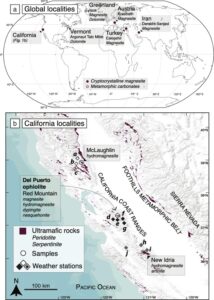Clumped-isotope thermometry of magnesium carbonates in ultramafic rocks
Magnesium carbonate minerals produced by reaction of H2O–CO2 with ultramafic rocks occur in a wide range of paragenetic and tectonic settings and can thus provide insights into a variety of geologic processes, including (1) deposition of ore-grade, massive-vein cryptocrystalline magnesite; (2) formation of hydrous magnesium carbonates in weathering environments; and (3) metamorphic carbonate alteration of ultramafic rocks. However, the application of traditional geochemical and isotopic methods to infer temperatures of mineralization, the nature of mineralizing fluids, and the mechanisms controlling the transformation of dissolved CO2 into magnesium carbonates in these settings is difficult because the fluids are usually not preserved. Clumped-isotope compositions of magnesium carbonates provide a means to determine primary mineralization or (re)equilibration temperature, which permits the …

